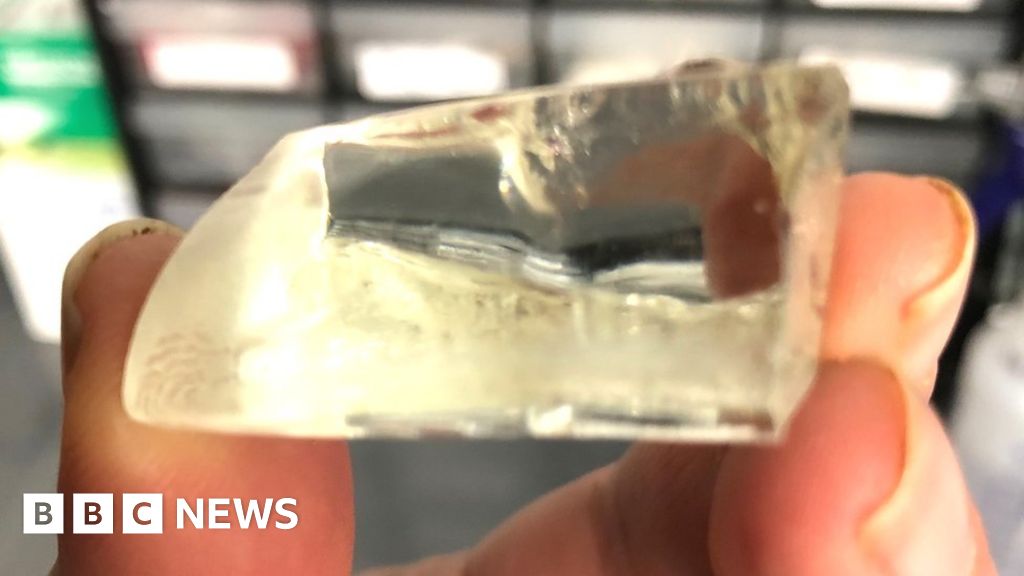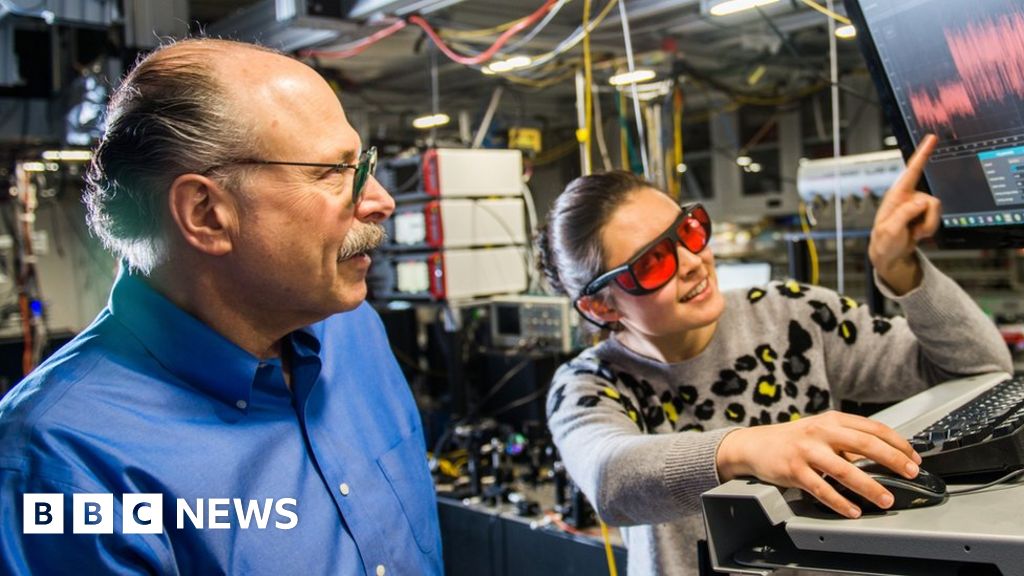
- Posted by Chris Baranyuk
- Business reporter technology
image source, Penn State University
Professor John Mauro has spent his career working on glass
There’s laughter over the phone as John Mauro puts my question to one of his students: How much hammering does it take to break the new glass they’ve developed?
“You have to put your body in it,” says Professor Mauro, of Penn State, who describes how the glass must first be deeply scratched with a diamond pen or tungsten carbide — and then hammered by a postdoctoral student. hammer.
Professor Mauro claims that the invention, called LionGlass, is ten times stronger than standard glass. Imagine a bottle of wine intact, even after it’s been dropped on the kitchen tile floor.
However, few details are available about LionGlass since the research hasn’t been published in a peer-reviewed journal yet, and the team recently filed a patent application.
One key detail is that, unlike standard glass, the production of this glass does not require soda ash or limestone. Alternative ingredients at the moment are a closely guarded secret.
People have been Making glass for thousands of years. Due to its jewel-like properties and the fact that it can be molded into intricate shapes, it has always had an Achilles’ heel: it shatters. But maybe not for much longer.
From car windshields to champagne flutes, there is no end to the applications that might benefit from even more durable glass.
There is a lot of competition as to who can make the strongest and most sustainable glass at a reasonable price. It can change the world.
“If we really want to have an impact on the carbon footprint, we need to tackle soda-lime silicate,” says Professor Mauro.
Soda ash and limestone release carbon dioxide (CO2) when heated with quartz sand—a common recipe for glass—and the manufacturing process takes high temperatures, using a lot of energy.
Its creators say Lion Glass is extremely strong and takes less energy to make than regular glass
By contrast, LionGlass does not use these carbon-rich materials and has production temperatures below 300°C to 400°C.
The catch is that because glass has a lower thermal tolerance than other glass, it cannot be used for smartphone or tablet screens, which are in high demand.
To do this, the glass must be able to handle the high temperatures during the production process.
“If the glass changes its dimensions during this process, the pixels can in fact be misaligned,” says Professor Mauro.
But LionGlass could have many other uses – glass cutlery and windows in buildings, for example.
Existing glass-making facilities should be able to make it without changing their equipment and glass requires no further work once it is made. Its strength, Professor Mauro says, is “an inherent property of the vitreous structure”.
LionGlass could have an impact “everywhere you see glass” — except in smartphones — says Robert Ritchie of the University of California, Berkeley.
Professor Ricci and his colleagues have developed an opaque glass that is stronger than steel Almost a decade ago.
A new type of glass could help architects rethink how they use the material, says Cheryl Atkinson, of Atkinson Architect in Canada. LionGlass, being so strong, can allow for much thinner window panes, for example.
“This would certainly reduce the weight of the insulated or triple glazing units,” she notes, noting that this would reduce the carbon dioxide emissions associated with glass transportation.
Corning Gorilla Glass is used in smartphones
However, one problem with current window technology is that the plastic seals around the edges of double or triple glazed units often fail after a few decades – it’s not all about the quality of the glass itself.
Additionally, recognizing the importance of energy efficiency, architects, including Mrs. Atkinson, use less glass in their designs to reduce heat loss from buildings in winter and prevent excessive indoor heating on sunny days.
Professor Mauro’s former employer, Corning, famous for the Gorilla Glass used in smartphones, tablets and TV screens, makes other products such as glass for ultra-tough drug vials – including for Covid-19 vaccines – and architectural glass for buildings.
Jaimin Amin, Corning’s chief technology officer, told the BBC the company had a project looking for “very high quality” energy-efficient windows.
One way this could be used is by applying a very thin layer of glass between two panes of traditional windows to make triple-glazed units that are thinner and lighter than current windows, he says.
phone glass
In July, Corning reported weak smartphone demand in a quarterly earnings update.
Still, Amin says consumer electronics remain a major growth area for the company.
Smartphone makers use glass for their device bodies, as well as screens, in part because this helps phones receive and transmit high-frequency 5G signals, Corning says.
Meanwhile, durability continues to improve.
The Victus 2 Gorilla Glass that Corning launched last year can survive being dropped onto concrete from a height of one meter. “It was the first time we had a cup with certified recycled content,” says Dr. Amin. “We are moving more and more in this direction.”
One of the benefits of glass recycling is the lower temperatures needed to make the new product, which reduces carbon emissions.
image source, Getty Images
Making glass is an energy-intensive activity
William Kerwin, an analyst with Morningstar Research Services, underscores Corning’s success in the glass business, saying it has more than half of the market for glass used in increasingly popular large-screen TVs.
One rapidly expanding application of glass is solar panels. “This is a place where I think if you had asked me five years ago, I wouldn’t have even called,” Kerwin says. “Now it is definitely a much bigger deal for the glass industry.”
He adds that solar panel manufacturers are looking for stronger and thinner glass so they can reduce the weight of the panels.
Ben Wood, of CCS Insight, says smartphones will continue to be an important area for innovation.
For example, foldable phones have to withstand “tens of thousands or hundreds of thousands of folds over the life of the device,” he says.
Consumers still worry about whether foldable phones are really powerful enough, he says.
“A dream is an unbreakable glass,” adds Wood — which remains a dream even now.

“Web maven. Infuriatingly humble beer geek. Bacon fanatic. Typical creator. Music expert.”




More Stories
A Boeing Starliner crew launch attempt was canceled shortly before the final countdown
Live updates from the Starlink Falcon 9 launch at the Cape
The orbiting solar module captures the Sun’s delicate corona in stunning detail [Video]